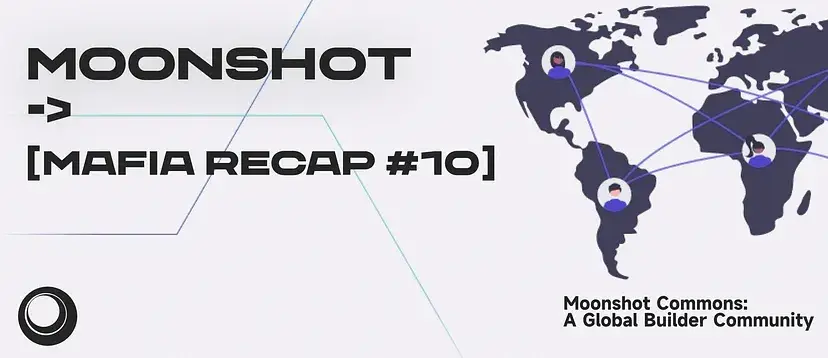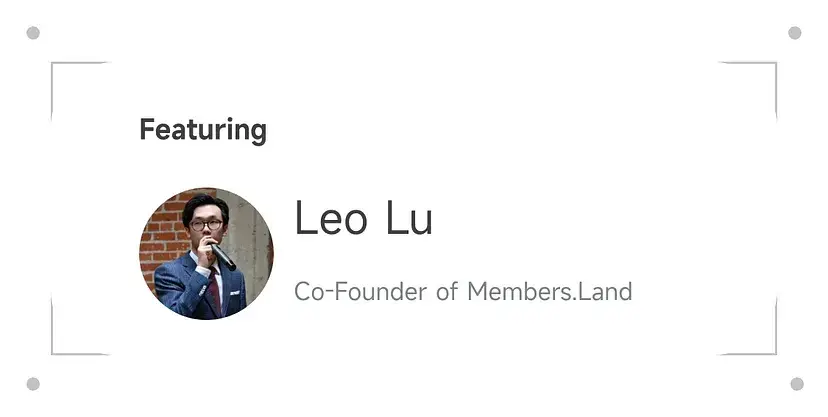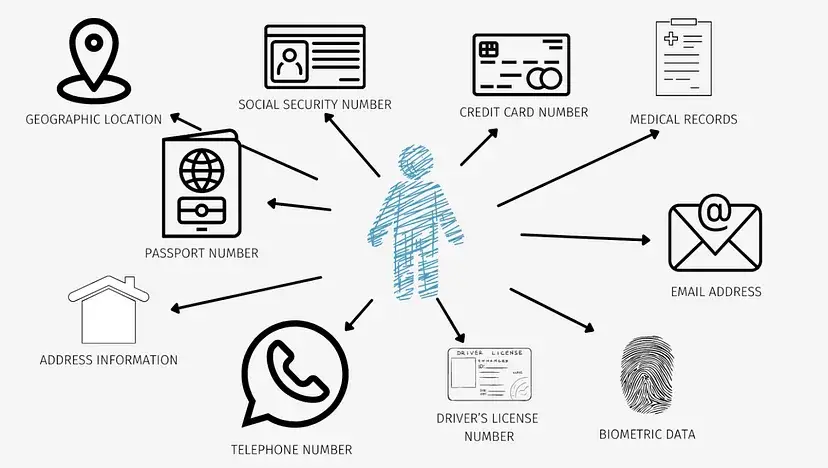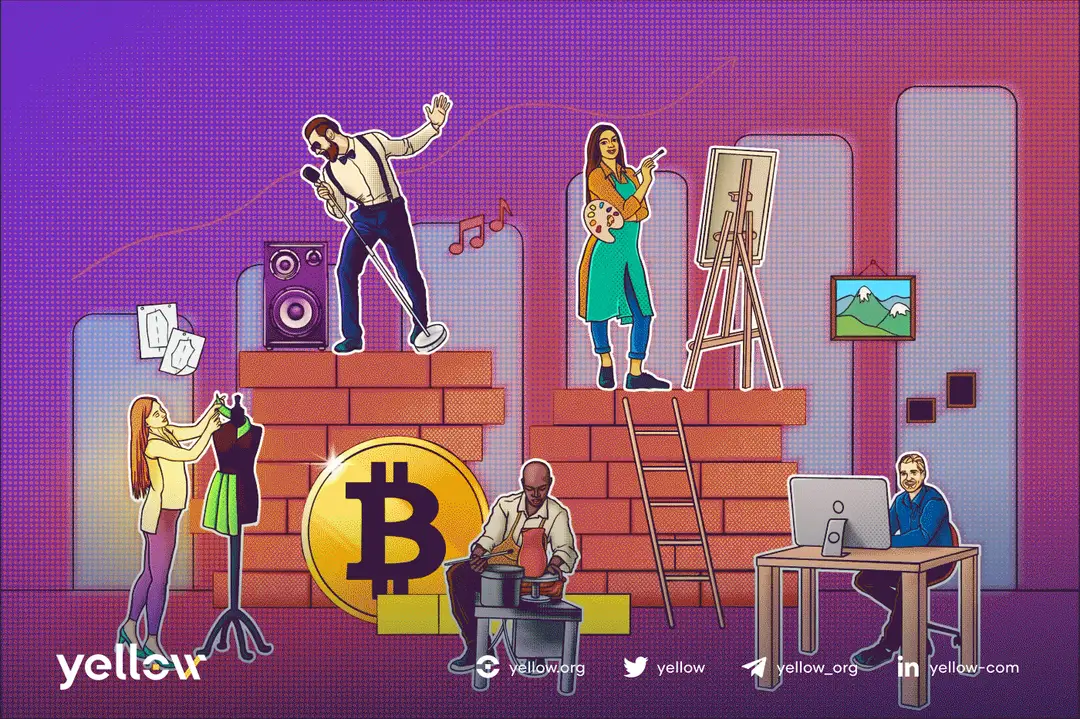“Decentralization is a utopian concept.” Today, many Web3 social platforms intend to subvert traditional social networking from the underlying structure and advocate anonymous social networking, but few people reflect on the meaning, positioning, and endowment of the product beyond the “gimmick” experiential value. Leaving aside the label of Web3, social pain points are reflected in various communities. Discovering strategies to tackle the obstacles one at a time while providing effective assistance for the development and operation of the community is a continuous pursuit.
Members.Land, formerly known as Chataverse, is a community management software designed to help creators and brands use NFT technology to build their decentralized membership system. Creators and brands can sell membership NFTs, deliver exclusive perks, and manage their communities all in one place. Members.Land also participated in the Moonshot 2022 Summer and Winter Hackathons and was successfully selected for YC Batch W23.
At Moonshot Commons’ Web3 Fireside Chat #10, we had a great conversation with Leo, co-founder of Members.Land, about the beginning of Members.Land, his views on decentralized social networking, and his long-term aspirations.
Key Takeaways:
1.NFTs are currently primarily driven by transactional value, but they have the potential to become more focused on personal identity and display in the future.
2.Decentralization is not achievable in every field, but it can bring significant benefits to certain industries, such as IP, where it allows creators to truly own their assets.
3.Currently, the Web3 community and social networking are driven more by financial attributes or a strong financially binding state.
4.To achieve mass adoption, Web3 social platforms should focus on solving real-world problems and bringing value to users rather than just offering monetary incentives.
5.Web3 social networking is not yet mature and doesn’t have a clear use case. Getting involved in the Web3 community requires investing time, effort, and resources, and cannot be achieved by simply buying NFTs or using tokens.
6.Regardless of whether it is in Web3 or Web2, entrepreneurs should prioritize solving problems for users instead of solely focusing on hype models. Entrepreneurs should focus on solving real problems for users and evaluating potential options before blindly jumping on the Web3 hype.
“Decentralization will be more efficient and can deliver direct, immediate values to the current society.”
Moonshot Commons:
Most of your past experiences were in private equity. How did you come into contact with the Web3 social network?
Leo:
When I was in college, I had many internships. I started working in private equity in the traditional financial industry as a freshman, then worked in PM (Product Management) at Tencent, and recently worked in PM for JP Morgan’s financial technology. One of the internships was at the end of 2020. I was working in services in blockchain-related business in a consulting company and had a preliminary understanding of Web3. Later, I went to Tencent for an internship and also worked part-time in a start-up company. I participated in NFT and crypto transactions and was able to explore the industry more deeply.
In 2021, I officially entered the Web3 space. In the first half of 2022, the co-founder and I participated in various hackathons, which eventually led to the creation of Members.Land. We also secured some funding for our project.
Moonshot Commons:
Artist Ian Cheng launched an NFT named “3FACE” which predicts personality traits based on the public transaction history of a digital wallet, thereby creating an alter ego. Do you believe that NFTs are an effective way of displaying personality traits or depicting one’s network of relationships? Moreover, what is the significance of NFTs in the current Web3 ecosystem? Leo:
Currently, most individuals focus primarily on the transactional value and financial aspects of NFTs. NFTs can be likened to an open market where many experts engage in buying and selling.
While the notion of using NFTs as a Web3 personal identity is impressive, it is important to consider the financial aspect. For instance, if you have invested a significant amount of money, only to see it drop by 99% and become worthless overnight, it can be devastating. Many of my friends and I experienced similar situations during the last bear market. Therefore, it is challenging to assert that NFTs are mainly driven by their financial value at this stage.
Yet, I believe that in the long run, the use cases of NFTs or the Soulbound Token proposed by Vitalik last year will shift towards serving as symbols of identity. In the future, more companies, organizations, or brands in the real world will refer to this form. However, as far as the current application level is concerned, this use case has not yet been widely adopted, and there are no products that can completely ‘break the circle’ and allow the people in Web 2 to understand and use NFTs or SBTs.
●Note: “Break the circle”, or “破圈” is a trending Mandarin phrase used to describe certain item, event, or phenomenon that goes beyond their typical realm of practice and becomes widely adopted by the mass.
Artist Ian Cheng’s work “3FACE” Source: Ian Cheng. Moonshot Commons:
Do you think that a decentralized social network is an inevitable trend?
Leo:
Decentralization is a utopian concept.
At least in our lifetime, it is unlikely to see the community achieve complete decentralization. Taken to the extreme, this amounts to no government, no control, and no central authority. I think that in certain fields, decentralization will be more efficient and can deliver direct, immediate values to the current society.
For instance, in the realm of IP (Intellectual Property), centralized platforms and companies often took a significant portion of the profits generated by content creators in music, video, and digital art. While these platforms provide advertisement and compensation, the returns are often inadequate compared to the value of the content produced.
Decentralization provides content creators with true ownership of their assets. In particular, the concept of digital assets is quite innovative, allowing a group of people to create more value and lead paradigm shifts on the road to decentralization. From a broader perspective, one day my driver’s license, real estate license, and ID card may all become decentralized and universal. However, this is difficult to achieve in a short time.
Moonshot Commons:
Is there any chance for the existing NFT community to ‘break the circle’? Or, which type of NFT do you think has the potential to ‘break the circle’ in the future?
●Note: “Break the circle”, or “破圈” is a trending mandarin phrase used to describe certain item, event, or phenomenon that goes beyond their typical realm of practice and becomes widely adopted by the mass.
Leo:
First of all, we need to see how we interpret ‘breaking the circle’.
If ‘breaking the circle’ refers to letting the public audience of Web2 buy NFT or enter this new field, then I think it still depends on influencers, well-known brands, or companies that everyone is familiar with. They will add a certain value to NFT — this value is something anyone can understand and is willing to pay for.
If we follow this line of thinking, NFTs created by established brands may have a better chance of ‘breaking the circle’. Porsche recently launched a 911 NFT that derives its value from the Porsche brand. As a Porsche owner, I would feel compelled to purchase this NFT as it creates a connection between the digital asset and the real-world experience. The potential for these types of interactions between NFTs and real-world scenarios is truly exciting.
Porsche 911 Series NFT. Source: Porsche. Gary Vee, a well-known person in the United States, has posted his own hand-painted NFT. Although it may not be considered good-looking, people will pay for his influence and to enter the community. He also operates a Flyfish Club in New York, which is similar to a restaurant specializing in kaiseki, but only NFT holders can enter. These interesting use cases such as “the first NFT restaurant” will encourage more people to promote NFTs, and it has become an opportunity to introduce NFTs to the Web2 public at this stage. “The use case of the NFT does not necessarily stop at a subdivided track of Web3, it can also focus on pain points in life. If the problem can be solved, then opportunities will naturally arise.”
Moonshot Commons:
What commonalities and needs do Web3 community users have in terms of communication, social networking, and governance? How is it different from the Web2 platform?
Leo:
Currently, the Web3 community and social networks are largely driven by financial incentives and the pursuit of profit. There are often many instances when we pay a lot of money for an NFT or have discussions revolving around how to make the next wave of profits. DAOs may incentivize users to contribute through governance tokens, economic systems, and token models. This format is innovative and has not been seen in the Web2 community, thereby resulting in the establishment of a tool built for this format. For example, there are various bots on Discord to solve problems, and on Snapshot where everyone can vote. In addition, there is currently no shortage of multi-signature wallets, which is convenient for everyone to manage assets together.
Another major feature of the Web3 community is anonymization. After all, everyone trades NFTs and other means. It has a certain common language or commonality, but a higher degree of anonymity will bring a different experience to the overall social interaction.
Data Anonymization. Source: DuoCircle. Moonshot Commons:
One of the biggest challenges facing Web3 social applications today is the small user base and poor user experience. What pain points do the Web3 social platforms have in terms of user acquisition? How far away is it from mass adoption?
Leo:
If you don’t consider the quality of customers, in the Web3 field, customer acquisition is fast and effective as long as you offer monetary incentives. However, this raises a concern: customers may be interested in your product solely for the potential profit it can bring, rather than its actual value.
If you aim to achieve mass adoption, your perspective should not solely focus on the benefits that Web3 can provide and how to apply them. Instead, it should be approached from the other direction — considering what can be enhanced in our society, recognizing that everyone has needs, and identifying the areas where Web3 technology can offer solutions.
Even facing Web2 or any ordinary company, the underlying logic remains the same: focus on products, not yourself.
If you want to motivate users, it is very simple. But if you want the project to be widely adopted and more influential, it is not enough to rely solely on an x-to-earn form. Once it involves your currency price and fluctuations, the long-term development of the product will naturally be affected.
I personally believe in long-termism. I think the team should think more about whether the product has brought certain value to users from the perspective of the product. Of course, the use case of the product does not necessarily stop at a subdivided track of Web3, it can also focus on pain points in life. If the problem can be solved, then opportunities will naturally arise.
Moonshot Commons:
Have you seen any specific use cases that should be improved?
Leo:
Going back to the point I mentioned before, there is a real pain point among art creators, as the value of their content often has to pass through additional layers or multiple intermediary platforms to reach their target audience or listeners.
Eliminating these unnecessary intermediaries, enhancing the interaction between creators and fans, and increasing the motivation of creators would be a good entry point. This is a relatively large demand, and I believe many artists would opt to create on the Web3 platform.
But when it comes to broader needs, one that no one can fulfill at this stage is the Soulbound Token, that is, the identity certificate. For example, if I have a university diploma, which can serve as a qualification for job hunting in the future, verified and transferred through the university center. If the blockchain’s commonality allows me to obtain a certificate and display my resume in the form of an SBT in my wallet, companies or individuals can easily see which organizations have certified me, thus solving the trust problem.
There is no need for a centralized organization to provide trust as the blockchain itself does. This characteristic would significantly improve efficiency. However, I have not yet seen a viable use case for solving real-world problems with this feature.
Moonshot Commons:
You mentioned just now that you are pursuing long-termism, but scaling up a Web3 social network project takes time and comes with unavoidable uncertainties. What predictions or judgments do you have when strategizing the directions of the next stage of your company or yourself?
Leo:
We have recently been considering the positioning of our product and the magnitude of the problem it can solve. Initially, we wanted to offer a more user-friendly and Web3-native platform for the NFT community, which could serve as a replacement for Discord.
People often complain that Discord is cluttered and inconvenient to use, but the problem is that everyone uses it. As a community or social platform, which platform is the best to use? No matter how good the experience is, without users, it will naturally not be able to show its value.
Currently, we are facing a significant challenge in moving a group of users who have already formed usage habits and loyalties to a new platform in a relatively small market. We are also exploring other communities that may have similar needs for experience upgrades besides the NFT space. While NFTs are primarily a hobbyist experience focused on buying and selling, ultimately people are connected by their shared interests.
In addition, many communities are not bound by NFT. In everyday Web2 life, such as in some student organizations, there are similar management and communication requirements. Through recent interviews, we have determined that enhancing the user experience for the Web2 community would be a part of our strategy for our next phase.
Moonshot Commons:
What will be the specific aspects of this experience upgrade?
Leo:
A question I have been thinking about is: What value does NFT bring?
For now, it is your status symbol, a label. This is no less than spending hundreds of dollars to buy a graduation gown and a certificate when you graduate.
This is a testament to your life experiences. Can organizations with strong engagement use NFTs as membership proof, demonstrating that they are one of the distinguished members, or can they explore GameFi gameplay to showcase the achievements they have earned? By utilizing a similar operational mode, we aim to enhance the group’s interactivity and encourage more creators to contribute to the community.
DAOs in Web3 operate well using a token mechanism, but in Web2, people are not concerned with NFTs or collections. By separating the value brought by Web3 from its strict association with Web3, such as not requiring users to have a wallet, we can expand the application of the product in a wider range of use cases.
“How should you go about finding the hammer that belongs to you?”
Moonshot Commons:
As the social track gains more attention, how has your understanding and attitude toward it changed?
Leo:
The so-called Web3 social networking is not yet mature and doesn’t have a good use case. Some may believe that by purchasing NFTs, they are automatically entering the Web3 community and connecting with others. However, Web3 is not a threshold, a form of automatic certification, or a grant.
You can’t get in a circle directly. More often than not, you have to invest time in it.
Nowadays, people can still view NFT as a hobby or interest, bringing together a group of individuals who share the same passion or possess similar skills and beliefs. It’s comparable to spending the same amount of money on buying a car or joining a club.
But in some organizations, it is interesting to try to use tokens to incentivize community members. Typically, companies can only motivate employees with stocks, and it is challenging for customers or product users to promote and spread your ideas.
However, tokens can achieve the above effects quickly. Tokens enable more people to have ownership of the same thing, creating a common interest that binds everyone and provides more incentives for each member to contribute their resources. This results in a positive outcome, allowing everyone to connect and influence one another.
Moonshot Commons:
To provide advice to entrepreneurs in the same field, would you recommend exploring ways to overcome this kind of limitation and further explore the convergence of Web2 and Web3?
Leo:
Firstly, I must acknowledge that my personal experience in the field of Web3 is limited, and I can only share some of the insights I have gained during this time. In my opinion, regardless of whether it is in Web3 or Web2, we should prioritize solving problems for users instead of solely focusing on hype models. The first thing we should think about is: Are you solving problems for users and how would their experience be affected without you?
Before evaluating a solution, it’s essential to first identify the different ways to solve the problem. If you don’t use x-to-earn or other forms of incentivizing users today, what potential options do you have to accomplish the same scenario and achieve the same goal? If you review it in this way and feel that there are other ways to solve the problem more efficiently and at a low cost, then Web3 will not be your only solution. Don’t blindly make decisions based on external influences.
Moonshot Commons:
How would you define what you’re doing now? What kind of operating model are you building?
Leo:
We are currently undergoing a transformative stage, and there is no single definition that can fully capture the essence of our approach. What I can say is that we are drawing from successful practices within the Web3 community, such as the DAO’s incentive mechanism mentioned earlier, to make it easier for Web2 users to understand, participate in, and contribute to the community with minimal friction. We aim to move in this direction, regardless of whether it is on-chain or not, and ultimately achieve our goal.
Moonshot Commons:
You also mentioned that Web3 social networking is still in an immature and incomplete state. If the project continues, will there be more transformations? How do you see the future direction of the product?
Leo:
I don’t know if through what I just said, everyone can sense that we cannot label our product simply as a Web3 product. Because we don’t have our token mechanism or an x-to-earn model, it’s not a real Web3 social product. We can only say that the Web3 community is one of the users we are facing.
Our current transformation is also equivalent to unloading the shackles of the past, and this is a matter of choice. Compared with the traditional definition of Web3, we will be more inclined to the concept of Web 2.5.
A while ago, during YC’s office hours, they mentioned that products cannot be Web3 for the sake of being Web3. You can’t take a hammer and say you will hit wherever the nail is. Using the hammer of Web3 is just one of your options. When facing so many choices, you should find your hammer. This is better than holding onto one hammer and finding its nail.










